Climate Disasters on the Planet from May 1 to May 7, 2024: Summary
South America
Brazil
Rio Grande do Sul, the southernmost state of Brazil, is experiencing an unprecedented natural disaster: extreme rains and
severe floods have already affected 401 out of 497 municipalities.
The state government has declared a state of emergency.
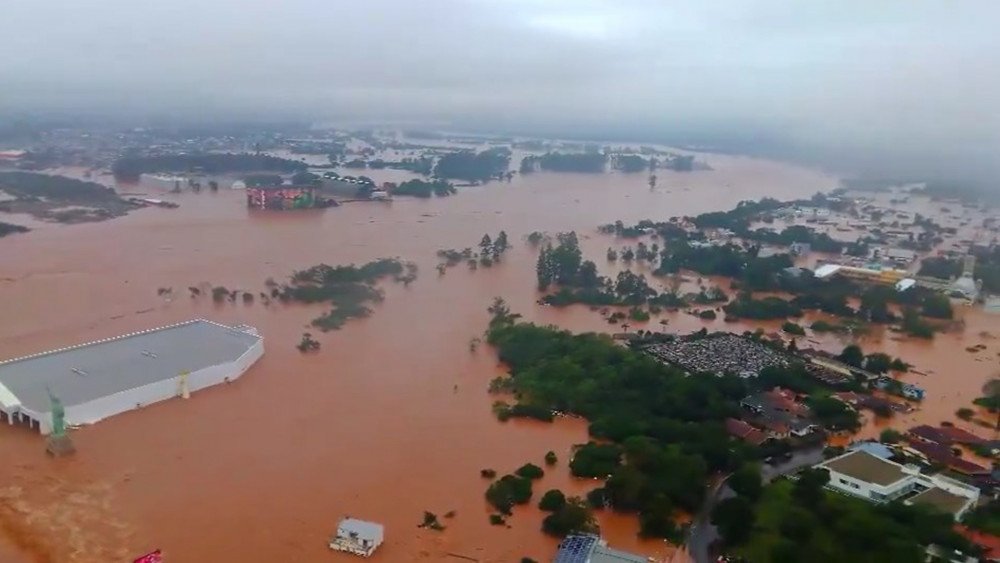
Unprecedented flooding in Rio Grande do Sul, Brazil
Extreme rains that began on April 22 continue to devastate communities, destroying infrastructure. This climatic tragedy has already resulted in the deaths of at least 95 people, with more than 130 still listed as missing.
The number of people affected by the floods is approaching 1.5 million,
of whom more than 200,000 are left homeless.

Homes submerged up to their roofs as a result of abnormally heavy rains, Rio Grande do Sul, Brazil
From April 22 to May 6, Rio Grande do Sul received as much rainfall as the average five-month total. For example, Caxias do Sul region during this 15-day period saw about 694 mm of precipitation. Meanwhile, according to the National Institute of Meteorology, the average total precipitation from January to June here amounts to 701 mm.
The incessant rains have destroyed bridges and blocked roads, leaving several communities in the state completely isolated. Several highways have been closed. Strong water currents washed away a section of the BR-290 highway in Eldorado do Sul.
The water level in the Taquari River exceeded 30 meters, marking the highest level in history.
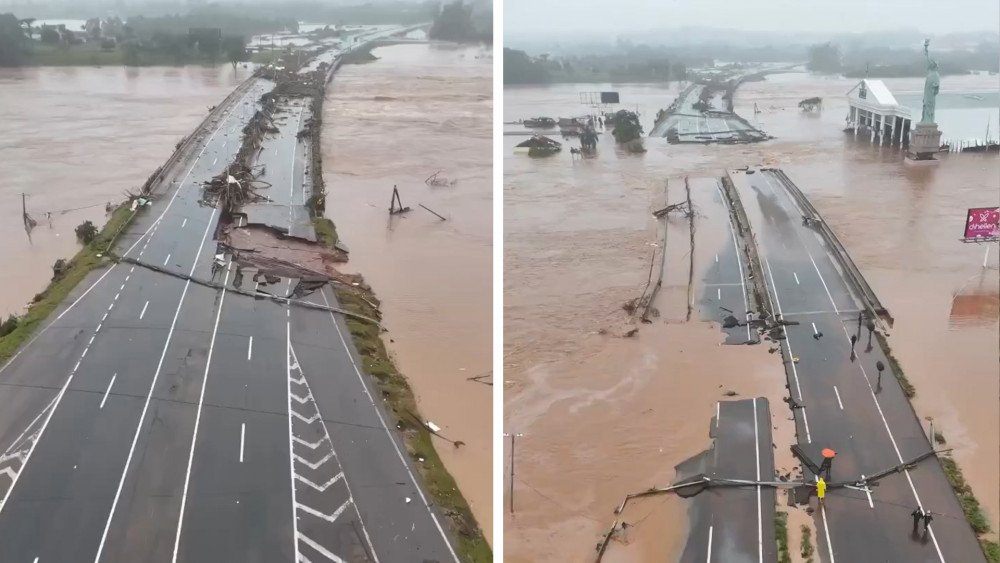
Destructive aftermath of extreme precipitation on the highways in Rio Grande do Sul, Brazil
The rains devastated the municipality of Sinimbu in the Rio Pardo valley. According to the mayor, “the city is 100% destroyed, there is no longer any commerce, industry, or jobs, and all public buildings were affected.”
The situation in Rio Grande do Sul became even more dramatic when on May 2, one of the main dams in the city of Caxias do Sul burst, exacerbating the already severe flooding in the Taquari River valley.
On the same day in the state capital, Porto Alegre, Lake Guaíba overflowed its banks. In the following days, the water level continued to rise and for the first time in history exceeded the 5-meter mark.
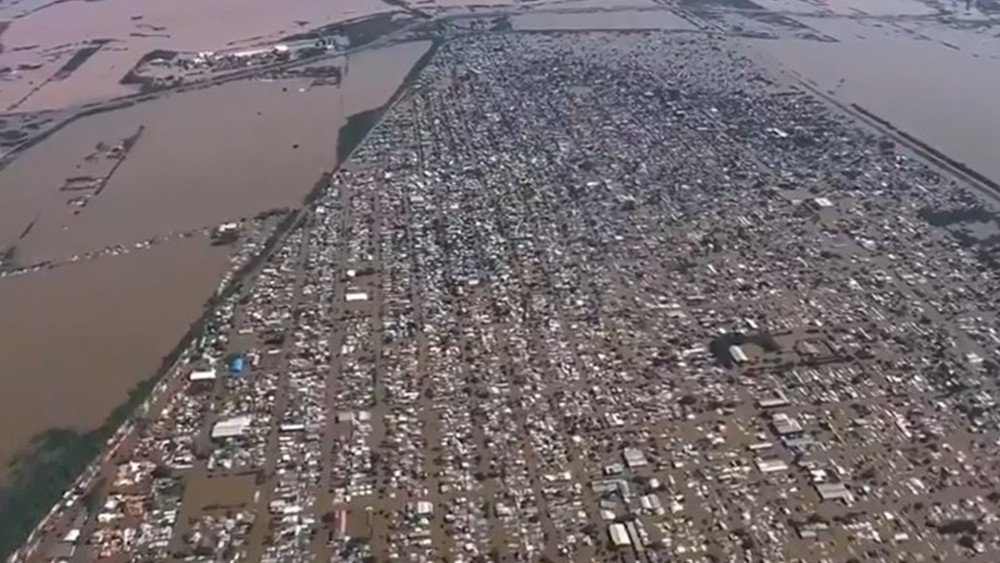
Huge scale of flooding, Rio Grande do Sul, Brazil
Porto Alegre, a city with a population of 1.3 million people, was flooded. Salgado Filho International Airport suspended all flights indefinitely as the runways were submerged under water.

Flooded Salgado Filho International Airport, Porto Alegre, Brazil
During the flood, an explosion occurred at a gas station in the northern zone of Porto Alegre, injuring people. The bus station was completely flooded, and all bus services to and from the city were canceled. Residents of the city were forced to take refuge on the roofs of their homes, seek shelter on viaducts and other elevated areas. Entire neighborhoods had to be evacuated. People left their homes waist-deep in water. In some places, the water level reached an adult's chest.
Rescue operations involved municipal security and fire services, civil and federal police, as well as military personnel.
Almost half a million people were left without electricity in Porto Alegre and remote towns, as power companies halted supplies due to safety concerns in flooded areas. Torrential rains and floods not only destroyed key infrastructure in Rio Grande do Sul but also led to the death of livestock, left farmlands underwater, and disrupted the soybean harvest.
Weather forecasts are grim: the continuation of rains is expected, which will further exacerbate the situation in areas affected by the floods.
North America
USA
From April 29 to May 4, powerful storms struck Texas, bringing rains, tornadoes, and large hail.
Massive floods
covered a third of the state.
Residents of 91 counties were affected, four of which were declared a “natural disaster area.”
In the city of Huntsville, nearly 508 mm of rain was recorded over six days.
Governor Greg Abbott, after inspecting the damage from the devastating floods in the city of Conroe and nearby areas, called it “enormous and catastrophic.”
As a result of the climate disaster, three people died: two adults and a child.
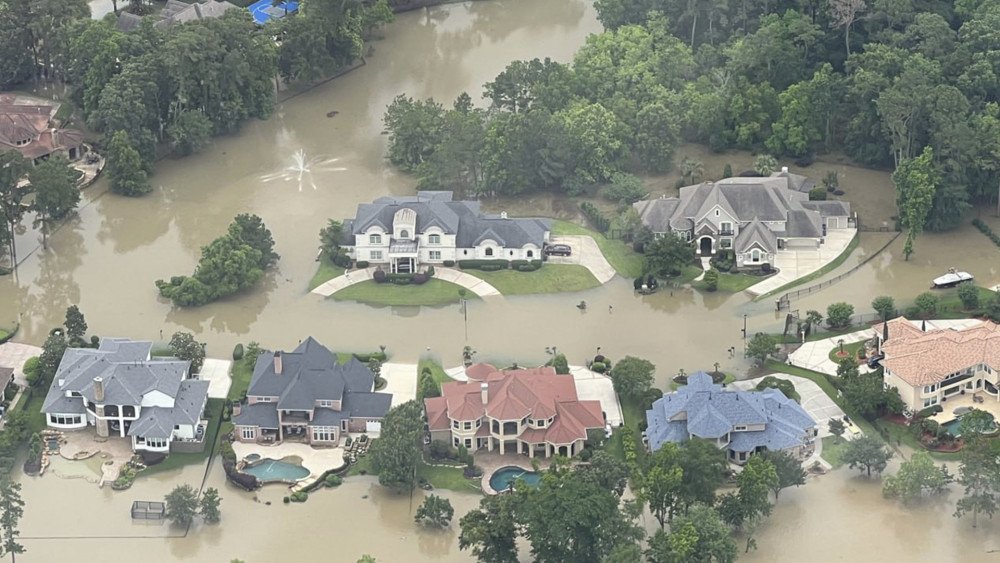
Flood in the vicinity of Houston, Texas, USA
In the evening of May 6, another series of convective storms struck the central United States with lightning, strong hail, and destructive wind gusts. Over 60 tornado warnings were issued. One of them, “Tornado Emergency Alert,” — the most severe of all warnings — was issued for Osage County, Oklahoma. An EF4 tornado caused colossal damage to the town of Barnsdall.
The city's power supply system was severely affected, and the main water supply line was completely destroyed.

Devastated outskirts of Osage County after the passage of a tornado, Oklahoma, USA
The tornado killed 1 person and injured about 8 others. This was the second tornado to hit the town in just five weeks.
“Tornado Emergency” is the highest level of tornado warning issued by the National Weather Service (NWS) in the USA. This warning means that significant, widespread damage is expected, and there is a high probability of numerous fatalities. This level of warning is intended to maximize the mobilization of the population for protective and rescue actions.
Another “Tornado Emergency” was issued by the National Weather Service in the small town of Union City, Michigan. For the first time in the state's history, a tornado warning of this nature was issued.
Another tornado caused significant damage in the city of Portage: residential and commercial buildings were damaged, trees were downed, and gas leaks occurred.
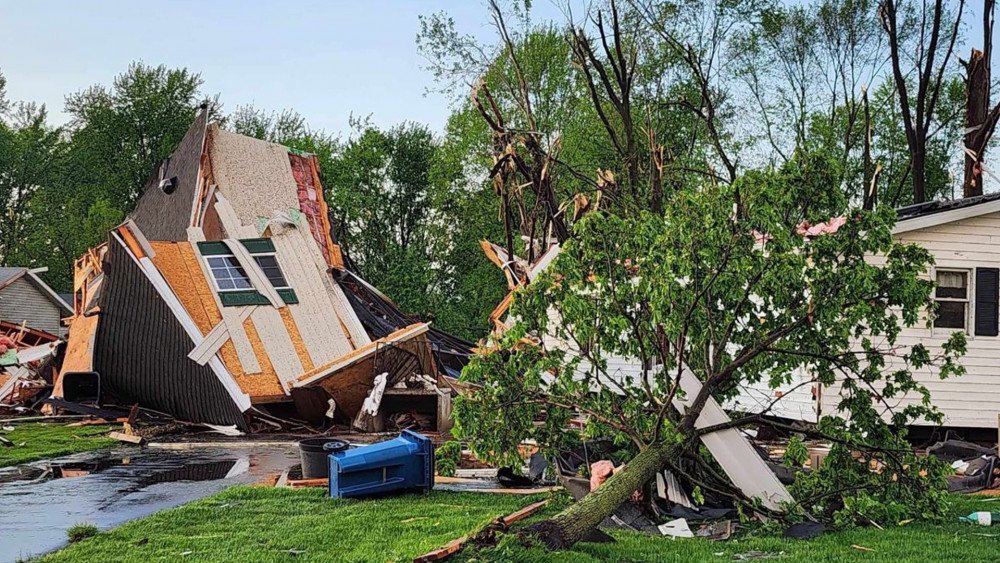
Aftermath of a powerful tornado in Portage, Michigan, USA
At least 176 homes were damaged at mobile home park. Throughout the county, at least 16 people were injured.
Asia
India
On May 2, the state of Manipur suffered from a strong storm. Torrential rains and winds swept through various parts of the state, damaging homes and power lines. Uprooted trees obstructed transport communication between the villages of Kairenbikhok and Wangjing. On National Highway 37, transportation was interrupted due to a landslide.
On May 4, in the districts of Thiruvananthapuram, Kollam, Thrissur, etc., of the state of Kerala, huge tidal waves crashed onto coastal villages, flooding homes and roads.
Local residents were forced to move to safer places. The sudden high waves were caused by the phenomenon “Kallakkadal.”
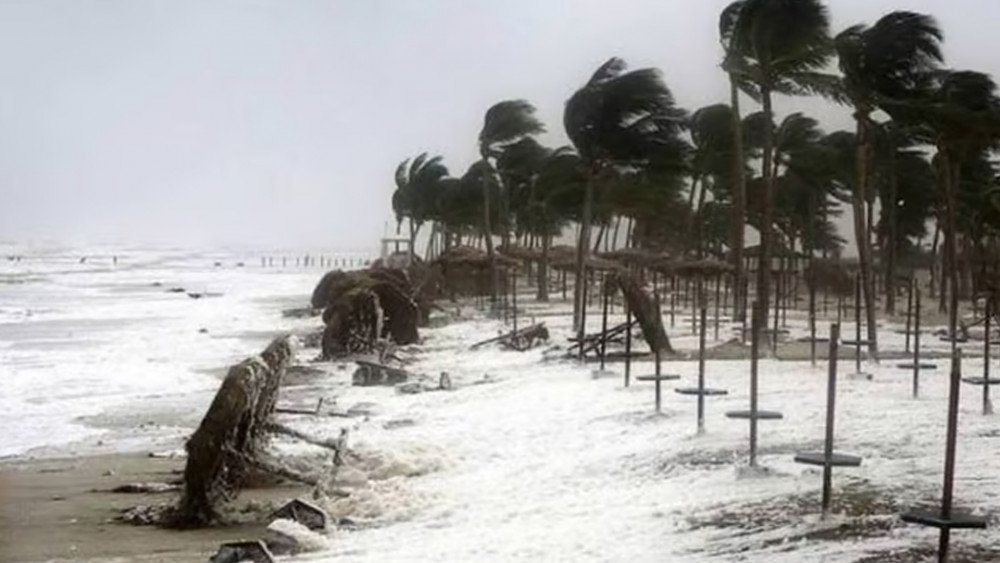
Huge tidal waves on the coast, Kerala, India
Kallakkadal is a phenomenon of sudden sea disturbances that cause strong waves in coastal areas. It occurs as a result of strong winds in the southern part of the Indian Ocean suddenly, without any noticeable prior change in local winds or coastal environment.
The Indian National Centre for Ocean Information Services (INCOIS) and the National Disaster Management Authority (NDMA) for the first time issued a “red” alert level in connection with the phenomenon “Kallakkadal.”
On May 5, in the district of West Imphal, Manipur, strong winds and rains with hail caused real chaos.
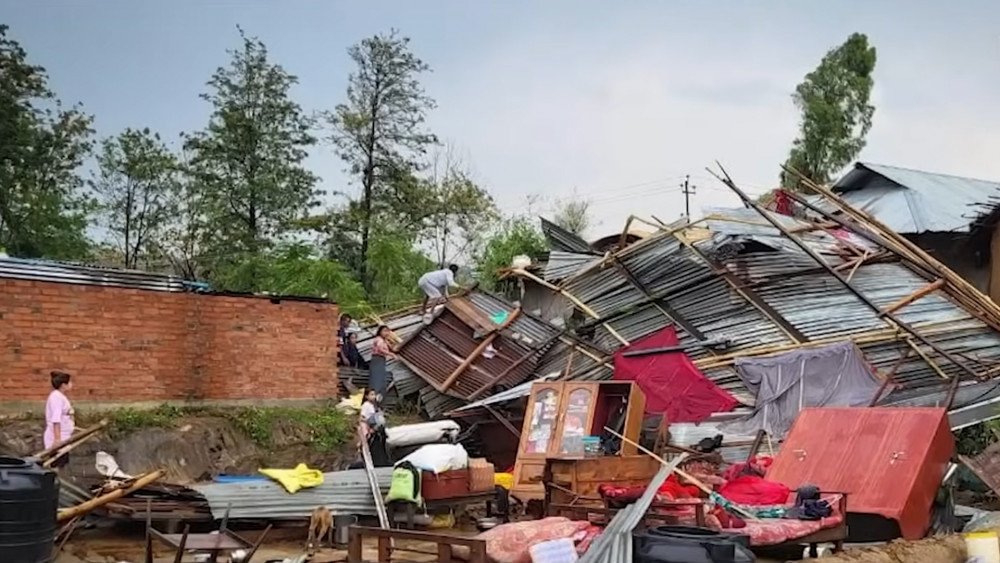
Destruction after the storm in Manipur, India
In many areas, the wind uprooted trees and tore down huts.
Hail damaged vehicles and left holes in tin roofs.

Large hail in Manipur, India
China
According to the Meteorological Department of Guangdong, the average rainfall in Guangdong province in April was 497.4 mm,
setting a historical record for the amount of rain in April.

Historical floods in Guangdong province, China
After several days of heavy rains, on May 1 around 2:10 AM local time, a sudden road collapse occurred on the busy Meilun Expressway. The collapsed section of the road was
about 17.9 meters long and covered an area of about 184.3 sq. meters.
Unfortunately, during the collapse, a large number of vehicles were on this section of the road, which fell along with the collapsing ground. Some of them exploded and caught fire.
The number of casualties as a result of the accident reached 48, and another 30 people were injured and hospitalized.

Collapse of a section of the highway in Guangdong province, China
On May 4, torrential rains again hit the southern province of China — Guangdong. Several districts issued the highest, “red,” alert level. This was the heaviest downpour recorded in southern China since 1961.
According to the Meteorological Department of Guangdong, in 7 populated areas of the province, more than 250 mm of rainfall was recorded in just 9 hours. The abnormal rains led to floods that turned many city streets into rivers. Evacuations from dangerous areas were conducted.
In the city of Zhongshan,
over 9 hours, the highest amount of rainfall was recorded — 385.9 mm.
And in two districts of the city, there was an unprecedented intensity of rain: 100 mm fell in three hours. Water level on some city streets was above the waist level. Many cars were filled with water, and some were even washed away.
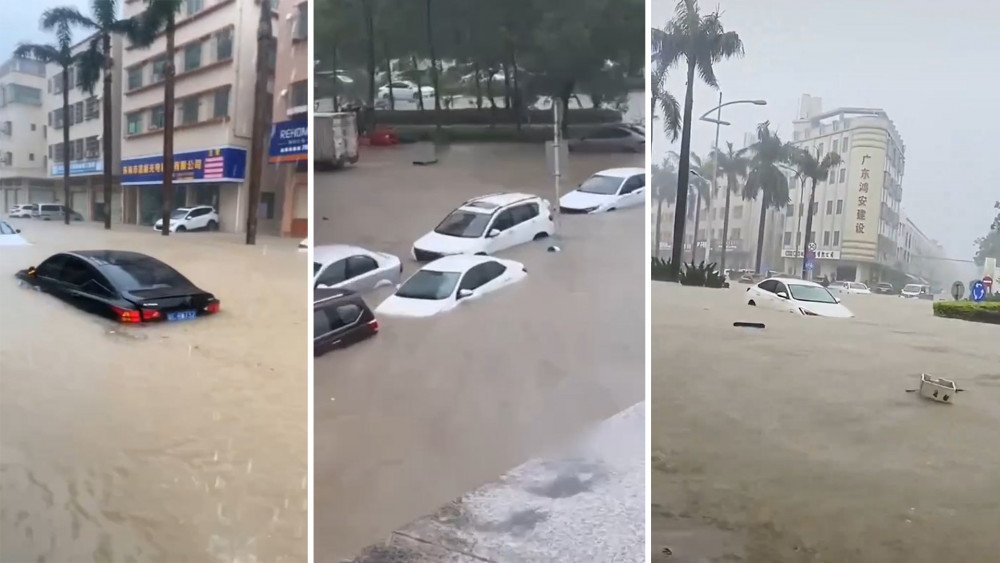
Massive flooding on city streets in Guangdong province, China
In Zhuhai, the weather station recorded 141 mm of rain in one hour.
This set a
record for the city for the amount of rain in an hour since observations
began in 1962.

Flood waters filled streets and buildings in Guangdong province, China
Rains led to the temporary suspension of some bus services. Also, due to the risk of landslides, on the day of May 4, the police closed part of the expressway.
Due to the flooding, an unexpected hazard arose: the outer wall of a crocodile farm in the city of Shenwan collapsed, and the crocodile breeding pond was washed away by water. As a result, four crocodiles “escaped” from the farm.
Three reptiles were driven back into the pond, but one crocodile remained outside its confines. Residents of nearby areas were ordered not to go outside.
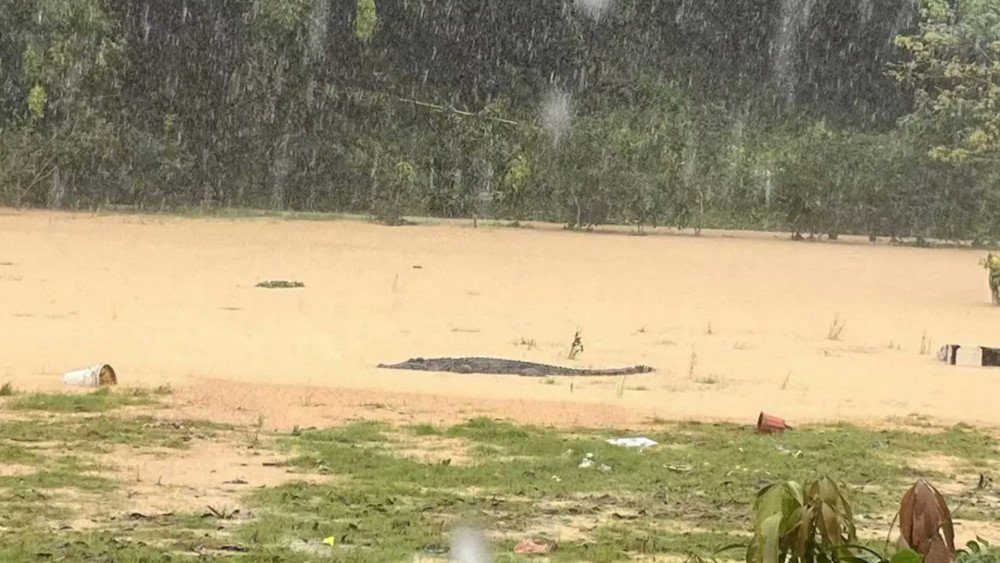
Crocodile escaped from a farm destroyed by flooding
Netizens posted messages saying, “In Guangdong, crocodiles are running away. What we are afraid of are the crocodiles...”, “Crocodiles, fierce animals, should not be bred. They may escape during a flood and cause harm to people.”
South Korea
On May 5, Jeju Island was hit by strong rain and wind,
comparable in intensity to a typhoon.
Wind gusts reached 30 m/s, and the rainfall was so intense that at the peak of Samgak, in the island's mountains,
a colossal 70.5 mm of precipitation fell in one hour.
Such a “water bomb” is rarely observed here, even in the midst of the summer during the peak of the rainy season.
The total rainfall for the day exceeded 700 mm.
Warnings for heavy rain, wind, and landslides were also issued for the southern coast of the country.
Here, the rains were as heavy as in the middle of summer.
In Namhae County of Gyeongsangnam-do, 146.3 mm of precipitation was recorded, and in Boseong County of Jeollanam-do, 197.5 mm.

Extreme amount of precipitation in 24 hours across several provinces of South Korea
Saudi Arabia
Since May 1, Saudi Arabia has been engulfed by heavy rains, leading to widespread flooding in various regions.
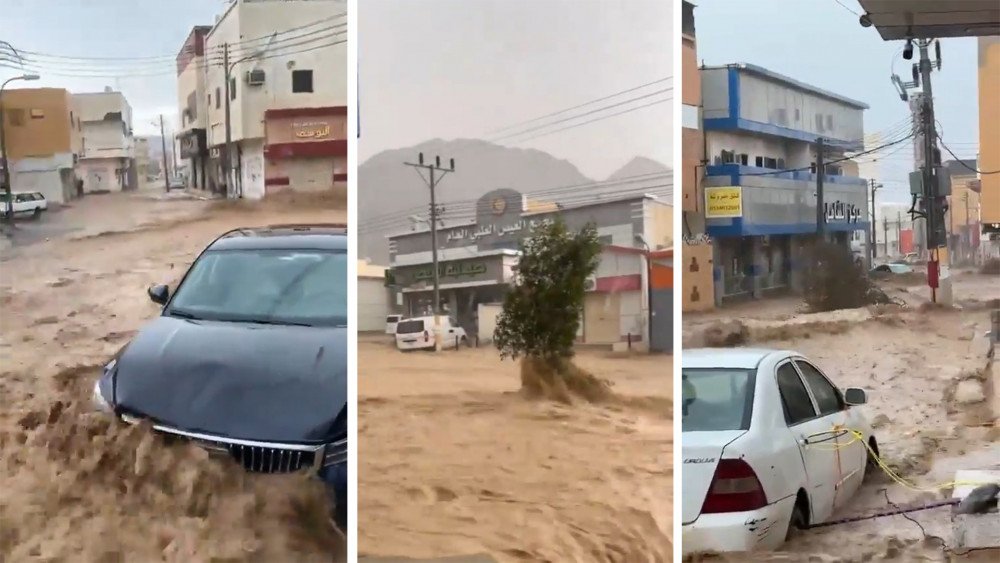
Aftermath of heavy rains, Saudi Arabia
In the city of Dammam, rains caused serious flooding, completely halting traffic on many streets, especially in the AlManar District.
At the same time, in the eastern part of Taif city, a powerful rainstorm with hail caused significant damage to residential homes and infrastructure in the Al Atif area.
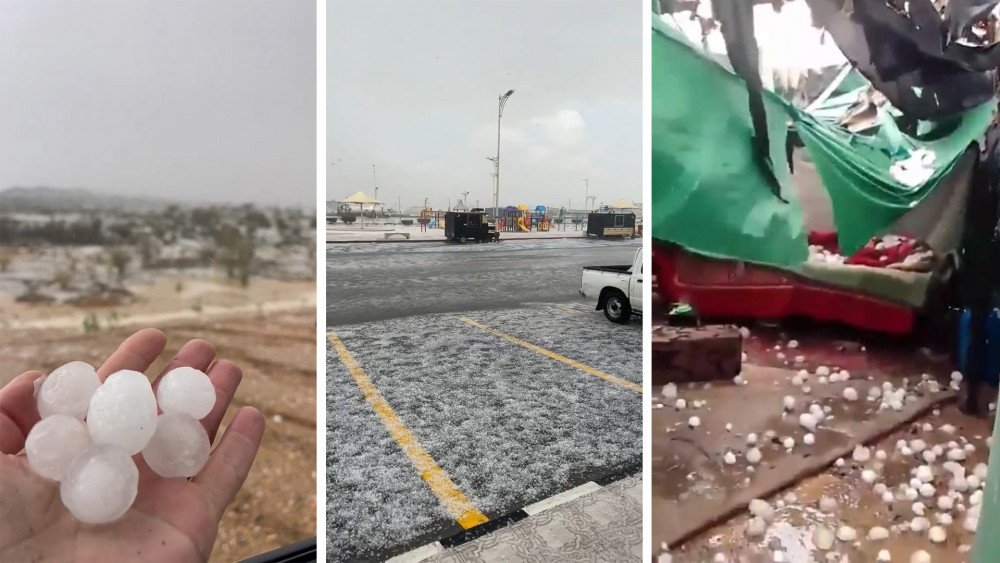
Hailstorm in Taif, Saudi Arabia
Saudi Arabian authorities canceled school classes in several regions of the Kingdom due to a new wave of torrential rains. In the administrative districts of Al-Qassim and Medina, as well as in the capital Riyadh, the National Meteorology Center issued a “red” alert.
Due to the storm, one person died and another went missing in the city of Balsamar.
UAE
On May 2, another storm hit the UAE. Due to the inclement weather, schools and offices were closed. Emirates airline canceled several flights.
In the areas affected by the rains, educational institutions switched to remote operation. Roads in valleys prone to flooding were blocked.

Aftermath of the new storm in the UAE
Iran
Since May 2, heavy rains in Iran have led to
serious flooding in 21 regions of the country.
Residential areas and agricultural lands were affected. The Red Crescent reported that the floods caused a crisis covering a significant part of the territory.
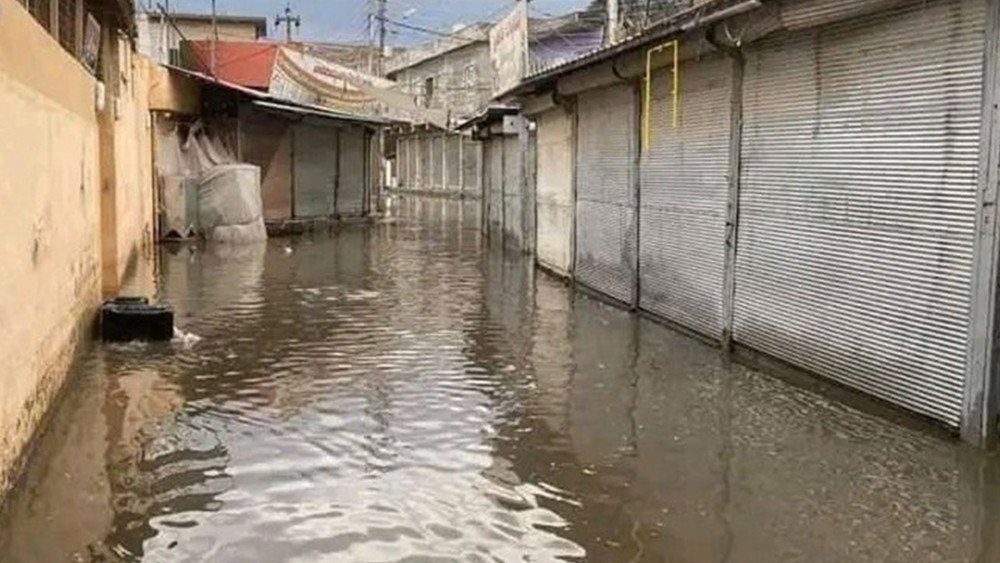
Floods resulting from heavy rains, Iran
In the city of Dezful, Khuzestan province, the precipitation reached 107 mm, which is six times more than what usually falls in May (the average monthly precipitation in May is 17.61 mm). Lake Zrebar overflowed its banks due to the rains.
In the city of Sarbisheh, in South Khorasan province, hail damaged homes and cars. Due to adverse weather conditions, flights by Iran Air were canceled.
Iraq
Since May 1, Iraq has been experiencing unceasing rains.
In the city of Erbil, heavy rain turned streets and homes into water bodies. Unfortunately, one person died, and three were injured.
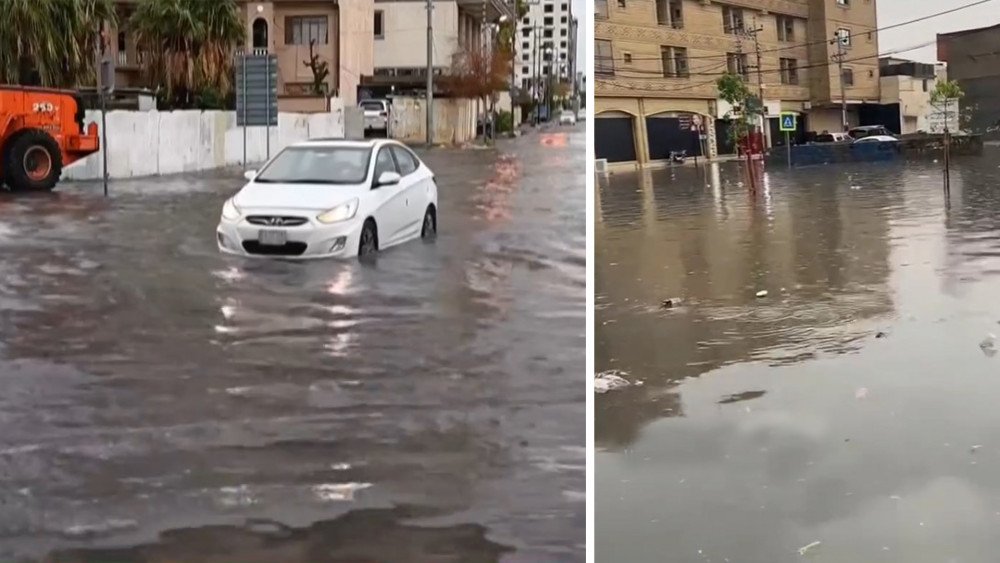
Aftermath of unceasing rains, Iraq
On May 2, in the center of Kirkuk province, 27 mm of rain fell, which is 5.4 times the monthly norm (the average monthly precipitation in May is 5 mm). Due to water flows, two main tunnels were closed. In the city of Samawah in southern Iraq, hail fell for the first time in 40 years.
On May 3, a strong storm struck the Halfaya oil field in Maysan province, causing huge damage. In Sulaymaniyah province, flooding swept away four climbers. In Diyala and Maysan provinces, rains caused homes to collapse and livestock to perish. Over two days, May 6 and 7, at least four people died and three were injured due to lightning strikes.
Türkiye
In the city of Cizre, Şırnak Province, on May 3, a sudden downpour with hail flooded buildings. Water streams swept away many vehicles. One parked car was swept by floodwaters and got stuck in a culvert, causing rainwater levels to rise and flooding the area.
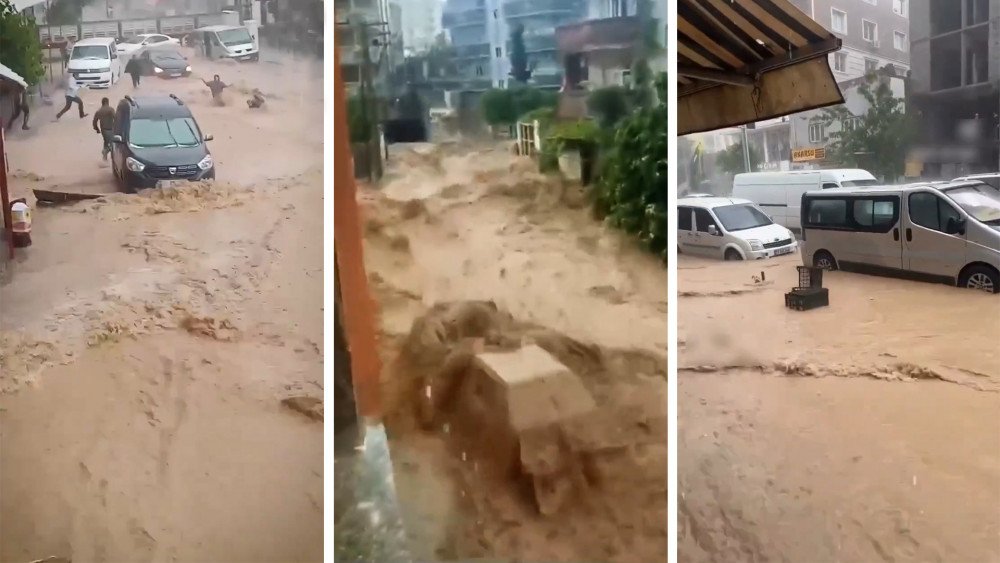
Powerful streams of rainwater wash away cars, Türkiye
Firefighters had to rescue bus passengers trapped by floodwaters. On May 4, in the city of Siirt, hail the size of walnuts fell.
Europe
Germany
On May 2, Europe was swept by strong storms with thunderstorms and heavy rains, seriously impacting several countries.
In Germany, storms caused destruction in the federal state of Baden-Württemberg. After a severe thunderstorm, the Klingenbach River overflowed its banks, flooding several communities. The town of Bisingen was particularly hard hit. Residents reported that
such a storm had not been seen in Bisingen for 40 years.

Aftermath of the strongest storm, Baden-Württemberg, Germany
The city of Albstadt was also severely affected. Hundreds of emergency calls were received. A police helicopter was deployed to assist the victims. Strong storms also hit the federal state of Hesse and its largest city, Frankfurt am Main. In a few hours, about a month's worth of precipitation fell — up to 50 mm of rain. This caused chaos in the city and paralyzed Frankfurt Airport for several hours. About 100 flights were canceled. Several hospitals were affected by the flooding. Markus Hospital was flooded. In Bethanien Clinic, water from the sewage system leaked into the intensive care unit.
In the Lower Franconia district, Bavaria, a tragic incident occurred: a man died from electrocution in his basement, which was completely flooded.
The Netherlands
The storms that day also affected the Netherlands. Strong thunderstorms with heavy rains passed over Limburg province.
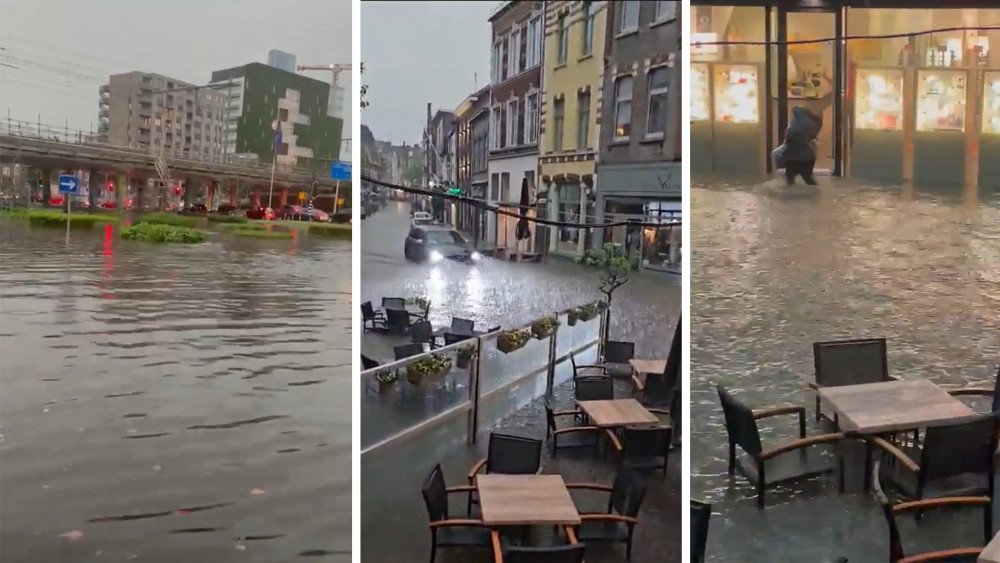
Floods on city streets in Limburg province, Netherlands
Part of the houses were struck by lightning. Some buildings were damaged by debris flow. The municipalities of Venlo and Heuvelland were particularly affected. North of Venlo, more than 70 mm of precipitation fell. This is
almost twice as much as usually falls for the entire month of May.

Aftermath of record rainfall, Netherlands
France
In the departments of Oise and Aisne, strong storms caused floods and significant damage.
In the town of Mouy, due to heavy rains, a stream overflowed its banks, flooding nearby homes. Local residents described the event as follows: “There was 75 cm of water in the house, I checked with a meter,” “I've never seen anything like this, it happened for the first time,” “I thought we were protected from this in Oise, I never thought water could come from the pond.”
In total, due to the floods in the department, the firefighters and rescuers of Oise received over 1,000 calls and conducted more than 200 rescue operations.
Armenia
From the evening of May 3 and over the next few days, Yerevan experienced heavy precipitation.
In the center and other districts of the city, homes, buildings, and office areas were flooded, and cars were stuck in water on the streets. There were disruptions in transportation.

Flood waters on the streets of Yerevan, Armenia
Due to rising water levels in the Voghjaberd river, a retaining wall collapsed, causing flooding in the Yerevan district of Nor Aresh.
In Yerevan and some villages of the Armavir region, hail covered the ground so densely that from a distance it was hard to distinguish from snow. The hail caused serious damage to farms.
Deputy Director of the Hydrometeorology and Monitoring Center, Gagik Surenyan, said he had never seen such a storm in Yerevan before.
Russia
At the beginning of May 2024, residents of many regions of Russia faced a sudden cold spell after abnormally warm weather at the end of April.
A sub-zero temperature anomaly spread
from Kaliningrad to Krasnoyarsk and from Murmansk to Krasnodar.

Sharp “May” cooling across a large area of Russia
A rare snow cover for this time of year settled in the Northwest, Central Russia, the North Caucasus, the Volga region, the Urals, and Western and Central Siberia. In Yekaterinburg, Tyumen, Kazan, Samara, Perm, and other Russian cities, heavy snowfalls occurred.
The situation was particularly severe in the Sverdlovsk region.
Snowfall and icy rains hit the region on the night of May 4, leading to a real collapse on the roads and causing
the most serious energy supply problems in the last 25 years.

Abnormal off-season snowfalls in Sverdlovsk region, Russia
Over two days, from May 4 to 5, Yekaterinburg experienced nearly a month's worth of precipitation — 47 mm (the average monthly precipitation in May is 49 mm).
Roads turned into real ice rinks within hours. For car owners who had already switched to summer tires, this posed a serious problem. Dozens of traffic accidents were recorded, including those with fatalities. Traffic from Perm to Yekaterinburg had to be stopped until special equipment arrived.
People were stuck in traffic for nearly 10 hours.

Due to abnormal snowfalls on the roads, snow drifts formed, Russia
The abnormal precipitation caused power line disruptions; the Internet and cell phone communications also suffered. According to energy experts, more than 1,700 trees fell on wires and other energy facilities, resulting in 1,140 km of damaged power lines, and dozens of power line supports required complete replacement. Due to the snowfall, more than 30 passenger trains were delayed, and 70 flights at Koltsovo Airport were delayed. According to the Ministry of Energy of the Russian Federation, on May 5, 79,000 residents of Yekaterinburg were left without electricity.
In the south of the country, frosts came after 30-degree heat. The early warmth caused many farmers to start sowing earlier, and plants had already begun to grow vigorously.
According to experts, the May frosts pose a serious threat to the future harvest of crops, not only slowing down fieldwork but also damaging already sprouted crops.
The climate disasters described in the article represent a minuscule part of what happened in the world in just a week. The forecasts voiced at a series of international forums “Global Crisis” are coming true with frightening accuracy.
The scale, strength, and number of disasters occurring on our planet continue to grow. And there are no grounds to believe that the process will just stop on its own. We cannot continue to ignore this problem. It is global, and solving it requires joint efforts.
You can watch the video version of this article here:
Leave a comment